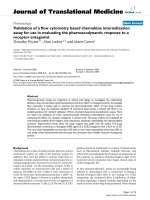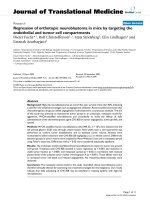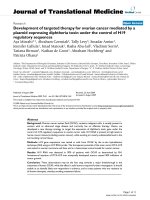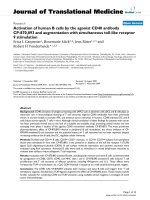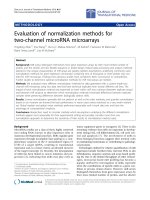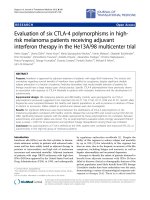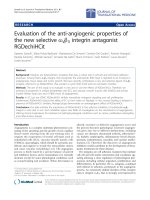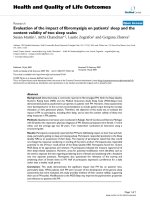báo cáo hóa học: "Evaluation of the impact of fibromyalgia on patients'''' sleep and the content validity of two sleep scales" pptx
Bạn đang xem bản rút gọn của tài liệu. Xem và tải ngay bản đầy đủ của tài liệu tại đây (244.29 KB, 7 trang )
BioMed Central
Page 1 of 7
(page number not for citation purposes)
Health and Quality of Life Outcomes
Open Access
Research
Evaluation of the impact of fibromyalgia on patients' sleep and the
content validity of two sleep scales
Susan Martin
1
, Arthi Chandran*
2
, Laurie Zografos
1
and Gergana Zlateva
2
Address:
1
RTI Health Solutions, 3040 Cornwallis Road, Research Triangle Park, NC, 27709, USA and
2
Pfizer Inc, 235 East 42nd Street, New York,
NY, 10017, USA
Email: Susan Martin - ; Arthi Chandran* - ; Laurie Zografos - ;
Gergana Zlateva -
* Corresponding author
Abstract
Background: Disturbed sleep is commonly reported in fibromyalgia (FM). Both the Sleep Quality
Numeric Rating Scale (NRS) and the Medical Outcomes Study Sleep Scale (MOS-Sleep) have
demonstrated positive psychometric properties in patients with FM. However, these assessments
were developed prior to the current recommendation to include patient input during the concept
elicitation or item generation phases. Therefore, the objective of this study was to evaluate the
impact of FM on participants, including their sleep, and to test the content validity of these two
sleep measures in FM patients.
Methods: Qualitative interviews were conducted in Raleigh, North Carolina and Detroit, Michigan
with 20 adults who reported a physician diagnosis of FM. Sixteen participants were female, 13 were
white, and the average age was 50 years. Two researchers conducted all interviews using a
structured guide.
Results: Participants consistently reported that FM had a debilitating impact on their lives and their
sleep, particularly getting to sleep and staying asleep. Participants responded positively to the Sleep
Quality NRS as an assessment of their sleep. The majority of participants stated that they would
not change the response numbering or wording of the item's anchors. Participants also responded
positively to the 24-hour recall period of the Sleep Quality NRS. Participants found the 12-item
MOS-Sleep to be appropriate and relevant; 19 participants indicated the measure captured all of
their sleep-related symptoms. However, areas for potential modification were identified, such as
the need to separate the item regarding awakening short of breath and awakening with a headache
into two separate questions. Participants also questioned the relevance of the snoring and
awakening short of breath items to FM. Half of participants expressed a preference for a daily
rather than a weekly recall period.
Conclusion: This study demonstrates the significant impact that FM has on patients' lives,
particularly sleep. While patients with FM were not part of the development of the generic sleep
assessments that were evaluated, this study provides evidence of their content validity, supporting
their use in FM studies. Modifications to the MOS-Sleep may improve the psychometric properties
and relevance to patients with FM.
Published: 10 July 2009
Health and Quality of Life Outcomes 2009, 7:64 doi:10.1186/1477-7525-7-64
Received: 25 February 2009
Accepted: 10 July 2009
This article is available from: />© 2009 Martin et al; licensee BioMed Central Ltd.
This is an Open Access article distributed under the terms of the Creative Commons Attribution License ( />),
which permits unrestricted use, distribution, and reproduction in any medium, provided the original work is properly cited.
Health and Quality of Life Outcomes 2009, 7:64 />Page 2 of 7
(page number not for citation purposes)
Background
Fibromyalgia (FM) is defined by the American College of
Rheumatology (ACR) criteria as chronic widespread pain
(present for at least 3 months) accompanied by pain upon
digital palpitation in at least 11 of 18 defined tender point
sites [1]. FM has an estimated prevalence of 2% of the
United States adult general population, with a greater esti-
mated prevalence among women (3.4%) than men
(0.5%) [2]. While pain is the defining symptom of FM,
commonly accompanying symptoms or conditions
include fatigue, disturbed sleep, anxiety, depression, irri-
table bowel syndrome, headache, concentration or mem-
ory problems, and numbness/tingling sensations [1].
Qualitative studies have elicited the key symptoms of FM
from the patient [3-14] and the clinician perspectives
[14], with results consistently indicating that sleep distur-
bance plays a prominent role in the disease. Estimates of
the percentage of FM patients experiencing some sleep
problem range from 74% in the population on which the
ACR criteria were established [14] to as high as 95% and
99% in two recent studies [15,16], Symptoms of disturbed
sleep in FM also have been shown to predict increased lev-
els of pain [15,16] and decreased levels of physical func-
tioning [15]. Not surprisingly, both patients and
clinicians have expressed the importance of targeting
sleep for treatment improvements; only the symptoms of
pain and fatigue received higher levels of endorsement in
ranking exercises [14]. Thus, the accurate assessment of
sleep changes associated with treatments for FM is of crit-
ical importance.
A wide range of sleep patient-reported outcome (PRO)
measures have been used in the study of FM, including
single-item numeric rating scales (NRS), visual analogue
scales (VAS), and various multi-item scales [17]. Two such
sleep measures, the Sleep Quality NRS and the Medical
Outcomes Study Sleep Scale (MOS-Sleep) [18], have dem-
onstrated strong psychometric properties, including relia-
bility, validity, and responsiveness, [19-24] specifically in
the FM patient population. Both of these PRO measures
were developed prior to the current emphasis on the
involvement of patients at the concept elicitation and
item generation phases [25], and neither was originally
intended as an FM-specific assessment tool. Therefore, the
objectives of the current qualitative study were to further
describe the impact of FM on participants' sleep and to
evaluate the content validity of both of these measures in
the FM patient population.
Methods
Participants
Eligible patients were between the ages of 18 and 65 years
(inclusive), were diagnosed with FM for 6 months or
more, and reported that FM affected their sleep. Exclusion
criteria included the presence of other factors that could
affect sleep, such as diagnosed sleep disorders; extenuat-
ing circumstances, such as a young child at home; or
night-shift work. To further confirm the FM diagnosis,
participants also responded to questions regarding the
nature, frequency, and location of their pain. Recruitment
took place in August and September of 2008 and for each
round of interviews, efforts were made to recruit partici-
pants diverse in gender, race, and educational back-
ground.
Procedures
The recruitment process for this study was initiated after
RTI International's Institutional Review Board reviewed
and approved implementation of the study, including the
participant consent form and all of the materials used for
recruitment. Participants for this study were identified by
two qualitative research firms, which contacted individu-
als interested in participating in qualitative studies either
through existing databases or Web advertisement. Trained
recruiters screened all respondents in an effort to find
individuals who were both eligible and interested in par-
ticipating in the in-depth patient interviews.
Each interview was conducted by the same two researchers
to ensure consistency of the questions and methods for
each interaction. The interviews lasted approximately 1
hour and were initiated only after participants had com-
pleted an informed consent form. An interview guide,
developed specifically for the study, was followed for each
interview. The interviews started with a general discussion
regarding the impact of FM on participants' lives and then
moved to a discussion about the impact of FM on the par-
ticipants' sleep. Following these open-ended queries, a
cognitive debriefing of the two PRO measures was con-
ducted [26]. Specifically, the participants were presented
with each of the measures; participants were asked to
complete each question using a "think-aloud" process
[27,28] and answer follow-up probes from the interview-
ers related to the content, wording, and comprehension of
the item. Participants were then asked to provide other
feedback on the measures, such as their relevance to FM,
and offer suggestions for improvement.
Measures
The Sleep Quality NRS is a single-item measure that
instructs the patient to "select the number that best
describes the quality of your sleep during the past 24
hours," where 0 is best possible sleep and 10 is worst pos-
sible sleep (Table 1). The MOS-Sleep [18] is a 12-item
measure that contains 7 subscales and 2 overall index
scores (a 6-item and a 9-item index) (Table 2). The MOS-
Sleep has demonstrated positive psychometric properties
in a broad range of patient populations [18,29-32,23,24],
including populations that, similar to those with FM, have
Health and Quality of Life Outcomes 2009, 7:64 />Page 3 of 7
(page number not for citation purposes)
chronic pain conditions that are accompanied by
impaired sleep, such as postherpetic neuralgia [29], dia-
betic painful neuropathy [30], and rheumatoid arthritis
[32].
Analysis
Interview results were compiled via audiotape and
detailed notes recorded during each interview. No tran-
scripts were created. Upon conclusion of the interviews,
both forms of documentation (audio and written) were
reviewed and analyzed to facilitate preparation of a com-
prehensive report. The report summarized findings on the
overall impact of sleep on FM, as well as the specific find-
ings and feedback on each PRO measure.
Results and discussion
Participant characteristics
Interviews were conducted in September 2008 in Detroit,
Michigan and Raleigh, North Carolina. As shown in Table
3, 20 men and women aged 29 through 64 years, with an
average age of 50.3 years, participated in the study. Across
interviews, the sample was predominately white (65%)
and female (80%). Participants reported having a diagno-
sis of FM for 8.9 years on average, and most of the partic-
ipants reported that a rheumatologist (40%) or a primary
care practitioner (35%) had initially diagnosed them with
FM. Responses to the screening questions indicated that
18 of the participants experienced pain every day, and the
remaining 2 participants experienced pain four to six
times a week. Additionally, each of the participants
reported pain in all four quadrants of their body, and their
average typical pain level was 6.0 on a 0- to 10-point scale
(0 indicating no pain and 10 indicating worst possible
pain).
Impact of FM in general and specific to sleep
Each interview began with a general discussion of partici-
pants' experiences with FM and related symptoms. Partic-
ipants provided a broad range of areas on which FM had
a significant and negative impact, including their mood,
family and social relationships, and work productivity.
One participant stated that "it affects every aspect of your
life" and that it was "very difficult to get relief from." Par-
ticipants also discussed the need to push themselves to do
Table 1: Sleep Quality Numeric Rating Scale
Please complete the following question upon awakening. Select the number that best describes the quality of your sleep during
the past 24 hours. (Circle one number only.)
012345678910
Best
possible
sleep
Worst
possible
sleep
Table 2: MOS Sleep Scale Subscales and Scoring
a
Subscale Number of Items Brief Description (Item Number on Scale) Scoring Range
b
Sleep disturbance 4 Trouble falling asleep (7); time to fall asleep (1); restless
sleep (3); awaken during sleep (8)
0 to 100
Snoring 1 Snore during sleep (10) 0 to 100
Awaken short of breath or with headache 1 Awaken short of breath or with headache (5) 0 to 100
Quantity of sleep 1 Quantity of sleep (2) 0 to 24
Optimal sleep 1 "Optimal" sleep (2)
c
0 or 1
c
Sleep adequacy 2 Enough sleep to feel rested (4); amount of sleep needed (12) 0 to 100
Somnolence 3 Feel drowsy during day (6); trouble staying awake during day
(9); take naps (11)
0 to 100
Sleep Problem Index II
d
9 Trouble falling asleep (7); time to fall asleep (1); restless
sleep (3); awaken during sleep (8); awaken short of breath
or with headache (5); enough sleep to feel rested (4);
amount of sleep needed (12); feel drowsy during day (6);
trouble staying awake during day (9)
0 to 100
a
See Additional file 1 for full MOS-Sleep Scale.
b
Higher scores indicate more of the concept being measured (e.g., higher Sleep Disturbance scores indicate greater sleep disturbances). Quantity
of Sleep scores are the patient-reported number of hours of sleep per night.
c
If the patient reports 7 or 8 hours of sleep per night, the Optimal Sleep score is 1; otherwise the Optimal Sleep score is 0.
d
Nine-item summary score, sometimes referred to as Sleep Index II. The 6-item summary scale (Sleep Index I) includes the same items, with the
exception of item 1 (time to fall asleep), item 3 (restless sleep), and item 6 (feel drowsy during the day), and was developed as a briefer alternative
to the 9-item index.
Health and Quality of Life Outcomes 2009, 7:64 />Page 4 of 7
(page number not for citation purposes)
activities and indicated that the fatigue they experience
makes even simple tasks, such as taking a shower, diffi-
cult.
When discussing the impact of FM on their sleep, half of
the participants reported difficulty getting to sleep due to
FM, and all but one reported difficulty staying asleep due
to FM. Those who had trouble getting to sleep commonly
reported that the pain of FM made it difficult for them to
get comfortable, and therefore, they often "tossed and
turned" in their attempts to find a pain-free position for
sleep. Participants who had difficulty staying asleep
reported that they were frequently awakened during the
night due to the pain of FM. Participants also spoke of no
longer feeling refreshed upon awakening since having FM,
regardless of the amount of sleep that they received.
Participants reported it was difficult for them to function
after a poor night of sleep, stating that the next day they
felt "groggy," "sluggish," or "foggy," and their mood and
concentration were also affected. Similarly, several partic-
ipants also commented on the cycle of increased pain and
poor sleep; one participant described this cycle as "pain
leads to a bad night, and a bad night leads to pain the next
day."
Table 3: Characteristics of cognitive interview participants (N = 20)
Characteristic Number (Percent)
a
Gender, n (%)
Male 4 (20%)
Female 16 (80%)
Age, years, mean (range) 50.3 (29–64)
Race
b
, n (%)
White 13 (65%)
Black 7 (35%)
Education,
b
n (%)
Advanced degree 3 (15%)
College graduate 2 (10%)
Associates degree 2 (10%)
Some college 9 (45%)
High school degree or equivalent 4 (20%)
Employment status
Employed full-time 5 (25%)
Employed part-time 1 (5%)
Unemployed 1 (5%)
Disabled 8 (40%)
Retired 3 (15%)
Other
b
2 (10%)
Years since diagnosis of FM, mean (range) 8.9 (<1–18)
Type of physician who diagnosed FM
Primary care practitioner 7 (35%)
Internal medicine specialist 2 (10%)
Pain specialist 1 (5%)
Rheumatologist 8 (40%)
Other
c
2 (10%)
Average (SD) of reported pain level
d
6.0 (1.6)
FM = fibromyalgia.
a
Unless otherwise noted.
b
One participant reported employment status as disabled and retired and is therefore counted in the Other category.
c
Two participants reported being diagnosed by multiple physicians and are therefore counted in the Other category.
d
On a 0–10-point scale where 0 indicates "no pain" and 10 indicates "worst possible pain." If participants provided two values (e.g., "6 or 7"), then
the midpoint was used (e.g., 6.5).
Health and Quality of Life Outcomes 2009, 7:64 />Page 5 of 7
(page number not for citation purposes)
Cognitive debriefing results
Sleep Quality Numeric Rating Scale
Relevance for fibromyalgia
Fourteen of the participants responded positively when
asked how well the Sleep Quality NRS captured the effect
of FM on their sleep, including participants who stated the
item was "perfect," the "best and most all-inclusive ques-
tion you could ask," and captured "broad overall quality."
When asked what aspects were missing from this ques-
tion, five participants said that specific details regarding
their sleep were not captured, such as the number of
awakenings through the night, the ability to go to sleep,
and difficulty getting up in the morning. Four participants
said that other factors influencing sleep were missing,
such as why the sleep had been poor and if medication
had been taken. One participant thought that the term
"fibromyalgia" should be included in the item, and two
participants thought that issues not related to sleep, but
related to FM, should be addressed, such as mood, appe-
tite, degree of pain, and level of fatigue.
Interpretation of sleep quality
When asked to describe the concept in their own words,
14 participants used the words "restful," "rested," "not
tired," or "refreshing" in their definitions of "sleep qual-
ity." Some participants also said the question was asking
them "how well" they had slept, if they had slept through
the night without awakening, and how much sleep they
had gotten.
Ease of administration and response scale
Participants generally responded positively to the format
of the Sleep Quality NRS, stating that it was easy to under-
stand and complete, and several participants commented
that it mirrored the way their physicians routinely
inquired about their pain level. Regarding the 0 to 10
response scale, most participants (n = 14) indicated that
they would not make any changes to the response num-
bering or the anchor wording. Three participants thought
that the anchors should be switched so that 10 would cor-
respond to the best possible sleep, because they associated
higher numbers with a better outcome, and three partici-
pants thought that fewer responses, such as a 5-point
scale, would be easier to use.
Recall period
Participants consistently said that remembering their
sleep over the past 24 hours was easy to do. Participants
indicated that they had been thinking of "last night" when
they completed the item, and a few indicated that unless
naps taken the prior day were of interest, that they would
recommend stating "last night" instead of "the past 24
hours."
MOS-Sleep
Relevance for fibromyalgia
In general, participants found the measure to be relevant
to their sleep symptoms, providing statements such as
"sounds like me in a nutshell," and when asked about the
item relevance, stating "all are relevant." However, partic-
ipants did provide additional feedback when reviewing
each of the individual items. For instance, many reported
that they did not think that they "spoke in their sleep,"
which was one of the examples for sleep that was not
"quiet" in item 3. Several participants also provided words
that they thought would better reflect their sleep than
"quiet" for item 3, such as "restful," "good," or "comfort-
able" sleep. Nearly every participant felt that item 5,
"awakening short of breath or with headache," needed to
be split into two questions if both concepts were retained.
While many thought awakening with a headache was rel-
evant for FM, most did not think awakening short of
breath was relevant. The item on snoring (item 10) was
rated as the least relevant overall, with 11 participants stat-
ing it was not important in FM.
When asked what aspects were missing from the MOS-
Sleep, participants generally mentioned other symptoms
or impacts of FM and not sleep-specific areas. For
instance, participants stated that questions could be
added about "anxiety," "mood," "confusion," "fatigue,"
"depression," or "joint pain." A few participants men-
tioned adding questions about medications or external
circumstances that could affect sleep. The only suggestion
that was specific to sleep symptoms was provided by a
participant who stated that a question about "trouble
waking up" or "getting out of bed" could be added.
To aid interpretation of the results for each measure, one
supplemental question was added after completion of the
fourth interview (and thus asked of only 16 of the 20 par-
ticipants). The question asked participants, if only one of
the two measures could be administered to FM patients,
which should be chosen. Fifteen of the 16 participants
stated that the MOS-Sleep should be chosen over the
Sleep Quality NRS given the greater detail it provided
about their sleep, an additional indication of the overall
relevance of the measure from the participants' perspec-
tives.
Ease of administration and response scales
Improvements to the format of the MOS-Sleep scale were
identified by participants. Half of the participants sug-
gested shortening the 6-point response scale; generally by
recommending consolidation of one or two categories
with similar verbal descriptions. For instance, four partic-
ipants said they would eliminate "a good bit of the time"
and a "little bit of the time," stating that they were too
similar to "most of the time" and "some of the time,"
Health and Quality of Life Outcomes 2009, 7:64 />Page 6 of 7
(page number not for citation purposes)
respectively. Additionally, an issue arose for four partici-
pants around the reversal of direction for MOS-Sleep item
responses; these participants had difficulty answering
item 4 because the directionality of the responses was
reversed from item 3 [see Additional file 1].
Recall period and timing of administration
Ten of the participants stated that they would prefer a
daily recall period versus the current 1-week recall period.
Many of these participants noted that it was too difficult
to remember and/or give an accurate answer over a period
of a week.
Discussion and conclusion
Similar to previous qualitative studies described in the lit-
erature, participants in this study expressed that FM had a
profoundly negative impact on their lives in general and
their sleep in particular. Many participants reported that
since having FM, they were no longer able to experience a
truly good night of sleep that would result in feeling
refreshed or rested upon awakening.
Participants' responses to general, open-ended questions
regarding the impact of FM on their sleep, as well as their
feedback upon item review, provide strong evidence for
the content validity of both PRO measures for comple-
mentary purposes. Specifically, the Sleep Quality NRS was
reported by participants to be relevant and appropriate for
addressing the overall impact of FM on their sleep. Fur-
thermore, participants stated that the overall assessment
of their sleep quality facilitated by this measure was both
important and similar to the type of information they pro-
vided to their physicians about the consequences of their
nocturnal FM pain. These findings, along with the brevity,
ease of use, and daily recall period provide further support
for use of the Sleep Quality NRS in both routine clinical
practice and in research studies as part of a patient diary.
The MOS-Sleep was considered to be of similar relevance
by the participants while providing a more comprehen-
sive and detailed assessment of the impact of FM on their
sleep. Nineteen of the participants said that the instru-
ment captured all of their sleep-related symptoms, indi-
cating likely concept saturation of these symptoms.
However, participants also provided evidence that the
MOS-Sleep could be modified to better fit patients with
FM. Several implications for further research arise from
these results. For example, eliminating "short of breath"
or at a minimum, separating it from "headache" in item 5
and eliminating item 10 (snoring) may improve the
measure's relevance and potentially its psychometric per-
formance within the FM patient population. Both items
were originally included to assess breathing-related sleep
disorders in the general population. Additionally, evalua-
tion of a shorter recall period and employing a 4- or 5-
point versus a 6-point response scale also could prove val-
uable. Regarding the implications for routine clinical
practice, while patients endorsed that the broader scope of
assessment of the MOS-Sleep offered valuable insight in
the sleep disturbance process associated with FM, the 12-
item scale requires more time for administration and scor-
ing and its use is likely to be limited to clinical research
rather than routine clinical practice.
A few limitations should be considered in evaluating this
study. One limitation is that participants had to experi-
ence sleep problems attributed to their FM symptoms to
participate because the study evaluated sleep assessments.
While concomitant sleep disturbance is reported for the
vast majority of patients with FM, with some recent stud-
ies reporting rates as high as 95% and 99% [15,16], this
study population is not representative of those FM
patients who do not experience disturbed sleep that they
attribute to their FM. Another important limitation of this
study is that only two sleep assessments were evaluated by
the participants; further work should assess other com-
monly used sleep assessments, such as the Pittsburgh
Sleep Quality Index [33], from the perspective of this
patient population. Nevertheless, this is the first effort to
establish the relevance and appropriateness of specific
sleep assessments directly by patients with FM. Further-
more, this study represents a pragmatic, research-based
approach to assess the content validity of PRO measures
developed prior to the current development standards of
patient involvement in the concept elicitation and item
generation phases. The results reported here support and
extend prior psychometric evidence supporting the use of
these two measures in the FM patient population.
Competing interests
The study was funded by Pfizer. Arthi Chandran and Ger-
gana Zlateva are employed by Pfizer. Susan Martin and
Laurie Zografos are employees of RTI Health Solutions,
who were paid consultants to Pfizer in connection with
the development of this manuscript.
Authors' contributions
SM contributed to the study design, data collection, inter-
pretation, and analysis of results and manuscript creation.
AC contributed to the study design, analysis of results, and
manuscript review. LZ contributed to the study design,
data collection, interpretation, and analysis of results and
manuscript review. GZ contributed to the study design
and manuscript review. All authors have read and
approved the final manuscript.
Health and Quality of Life Outcomes 2009, 7:64 />Page 7 of 7
(page number not for citation purposes)
Additional material
Acknowledgements
The authors wish to thank all of the patients with FM who participated in
this study.
References
1. Wolfe F, Smythe H, Yunus M, Bennett R, Bombardier C, Goldenberg
D, Tugwell P, Campbell SM, Abeles M, Clark P, et al.: The American
College of Rheumatology 1990 criteria for the classification
of fibromyalgia: report of the Multicenter Criteria Commit-
tee. Arthritis Rheum 1990, 33:160-172.
2. Wolfe F, Ross K, Anderson J, Russell IJ, Hebert L: The prevalence
and characteristics of fibromyalgia in the general population.
Arthritis Rheum 1995, 38:19-28.
3. Arnold LM, Crofford LJ, Mease PJ, Burgess SM, Palmer SC, Abetz L,
Martin SA: Patient perspectives on the impact of fibromyalgia.
Patient Educ Couns 2008, 73:114-120.
4. Henriksson CM: Living with continuous muscular pain-patient
perspectives. Part II. Strategies for daily life. Scand J Caring Sci
1995, 9:77-86.
5. Hallberg LRM, Carlsson SG: Psychosocial vulnerability and
maintaining forces related to fibromyalgia. Scand J Caring Sci
1998, 12:95-103.
6. Hellstrom O, Bullington J, Karlsson G, Lindqvist P, Mattsson B: A
phenomenological study of fibromyalgia. Patient perspec-
tives. Scand J Prim Health Care 1999, 17:11-16.
7. Hallberg LRM, Carlsson SG: Coping with fibromyalgia. A quali-
tative study. Scand J Caring Sci 2000, 14:29-36.
8. Raymond MC, Brown JB: Experience of fibromyalgia. Qualita-
tive study. Can Fam Physician 2000, 46:1100-1106.
9. Bernard A, Prince A, Edsall P: Quality of life issues for fibromyal-
gia patients. Arthritis Care Res 2000, 13:42-50.
10. Asbring P, Narvanen AL: Women's experiences of stigma in
relation to chronic fatigue syndrome and fibromyalgia. Qual
Health Res 2002, 12:148-160.
11. Sturge-Jacobs M: The experience of living with fibromyalgia:
confronting an invisible disability. Res Theor Nurs Prat Int J 2002,
16:19-31.
12. Cunningham MM, Jillings C:
Individuals' descriptions of living
with fibromyalgia. Clin Nurs Res 2006, 15:258-273.
13. Bennett RM, Jones J, Turk DC, Matallana L: An internet survey of
2,596 people with fibromyalgia. BMC Musculoskelet Disord 2007,
8:27.
14. Mease PJ, Arnold LM, Crofford LJ, Williams DA, Russell IJ, Humphrey
L, Abetz L, Martin SA: Identifying the clinical domains of fibro-
myalgia: Contributions from the clinician and patient Delphi
exercises. Arthritis Rheum 2008, 59:952-960.
15. Bigatti SM, Hernandez AM, Cronan TA, Rand KL: Sleep distur-
bances in fibromyalgia syndrome: Relationship to pain and
depression. Arthritis Rheum 2008, 59:961-967.
16. Theadom A, Cropley M, Humphrey KL: Exploring the role of
sleep and coping in quality of life in fibromyalgia. J Psychosom
Res 2007, 62:145-151.
17. White KP, Harth M: An analytical review of 24 controlled clin-
ical trials for fibromyalgia syndrome. Pain 1996, 64:211-219.
18. Hays R, Stewart A: Sleep measures. In Measuring Functioning and
Well-Being: the Medical Outcomes Study Approach Edited by: Stewart A,
Ware J. Durham: Duke University Press; 1992:235-259.
19. Crofford L, Rowbotham M, Mease P, Russell R, Corbin A, Young J,
LaMoreaux LK, Martin SA, Sharma U, Pregabalin 1008–105 Study
Group: Pregabalin for the treatment of fibromyalgia syn-
drome: results of a randomized, double-blind, placebo-con-
trolled trial. Arthritis Rheum 2005, 52:1264-1273.
20. Arnold LM, Russell IJ, Diri EW, Duan WR, Young JP Jr, Sharma U,
Martin SA, Barrett JA, Haig G: A 14-week, randomized, double-
blinded, placebo-controlled monotherapy trial of pregabalin
in patients with fibromyalgia. J Pain 2008, 9:792-805.
21. Mease P, Russell I, Arnold L, Florian H, Young J Jr, Martin S, Sharma
U: A randomized, double-blind, placebo-controlled, phase III
trial of pregabalin in the treatment of patients with fibromy-
algia. J Rheumatol. 2008, 35(3):502-514.
22. Crofford L, Mease P, Simpson S, Young J, Martin S, Haig G, Sharma U:
Fibromyalgia relapse evaluation and efficacy for durability of
meaningful relief (FREEDOM): A 6-month, double-blind, pla-
cebo-controlled trial with pregabalin. Pain 2008, 136:419-431.
23. Cappelleri JC, Bushmakin AG, McDermott AM, Dukes E, Sadosky A,
Petrie CD, Martin S: Measurement properties of the Medical
Outcomes Study Sleep Scale in patients with fibromyalgia.
Sleep Med 2009 in press.
24. Cappelleri J, Bushmakin A, Martin S, Petrie C, Dukes E, Zeiher B: The
Sleep Quality scale and the Medical Outcomes Study Sleep
Scale in subjects with fibromyalgia: Psychometric evaluation
and mediation effects. Sleep 2008, 31:A301.
25. Turner RR, Quittner AL, Parasuraman BM, Kallich JD, Cleeland CS,
Mayo/FDA Patient-Reported Outcomes Consensus Meeting Group:
Patient-reported outcomes: instrument development and
selection issues. Value Health 2007, 10:S86-S93 [http:www3.inter-
science.wiley.com/journal/118497777/abstract?CRE TRY=1&SRE-
TRY=0].
26. Frost M, Reeve B, Liepa A, Stauffer J, Hays R, Mayo/FDA Patient-
Reported Outcomes Consensus Meeting Group: What is sufficient
evidence for the reliability and validity of patient-reported
outcome measures? Value Health 2007, 10:S94-S105 [http://
www3.interscience.wiley.com/journal/118497778/abstract].
27. Sudman S, Bradburn NM, Swartz N: Thinking about answers: the
application of cognitive processes to survey methodology.
San Francisco: Jossey-Bass, Inc 1996.
28. Willis GB, Royston P, Bercini D: The use of verbal report meth-
ods in the development and testing of survey questionnaires.
Appl Cogn Psychol 1991, 5:251-267.
29. Hays RD, Martin SA, Sesti AM, Spritzer KL: Psychometric proper-
ties of the Medical Outcomes Study Sleep measure. Sleep
Med 2005, 6:41-44.
30. Rejas J, Ribera MV, Ruiz M, Masrramon X: Psychometric proper-
ties of the MOS (Medical Outcomes Study) Sleep Scale in
patients with neuropathic pain. Eur J Pain 2007, 11:329-340.
31. Lau DT, Morlock RJ, Hill CD: Psychometric evaluation of the
Medical Outcomes Study-Sleep Scale in persons with over-
active bladder. Clin Ther. 2006, 28(12):2119-2132.
32. Wolfe F, Miochaud K, Li T: Sleep disturbance in patients with
rheumatoid arthritis: evaluation by Medical Outcomes
Study and Visual Analog Sleep Scales. J Rheumatol. 2006,
33(10):1942-1951.
33. Buysse DJ, Reynolds CF III, Monk TH, Berman SR, Kupfer DJ: The
Pittsburgh Sleep Quality Index: a new instrument for psychi-
atric practice and research. Psychiatry Res 1989, 28:193-213.
Additional file 1
MOS- Sleep Scale. The data provided represent the full instrument ver-
sion of the MOS-Sleep Scale, including appropriate copyright informa-
tion. This document is also publically available at the following URL:
/>. Although
already publically available, the authors have also contacted the copyright
holders for permission to reproduce as an appendix to this article.
Click here for file
[ />7525-7-64-S1.pdf]

